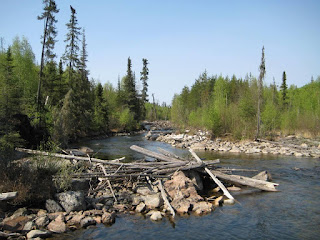Camp 3, eight km from previous camp and about one km from the lake outlet where I have to clear portages along a creek to get to the next lake.
The tarp shelter area was littered with winter scat from snowshoe hare (round pellets) and grouse or ptarmigan (long pellets). My thought was that I would not want to have little kids in tow at this site as they would probably be eating all of this "granola".
A common garter snake living in the boulders beside my campsite would often sun itself during the heat of the day.
A red-tinged sunset from forest fire smoke. This was one of the few days all season that I detected any evidence of distant forest fires.
There was a lot of very windy, cool weather buffeting my campsite near the lake so I put up the canvas tent inland about 100 metres.
Every waterway has beaver lodges and I saw many beavers.
Much to my consternation there was a very wide, very dirty all-terrain vehicle (ATV) trail where there used to be only a narrow portage, one that probably existed for hundreds of years before such things as motors. Unfortunately the new trail overrides and erases portions of the old. The new trail is several kilometres long, much too long for portaging my gear when there are shorter alternatives. I spent seven hours clearing the four old portages along the creek which empties one lake into another, at times having to make use of the ATV trail. Local Cree use this trail to ferry motor boats to and from the next lake.
I parked my canoe at the top end of the first uppermost unrunnable rapid and went on by foot to find and clear the canoe portages.
Three examples of areas of the old portages after clearing, much narrower and prettier than the scar that is the ATV trail. Such typical trails are walking paths.
The five rapids join large pools of water which can be canoed to the next portage. Different areas along the creek have been burned by forest fires over the years so there are various stages of growth.












































